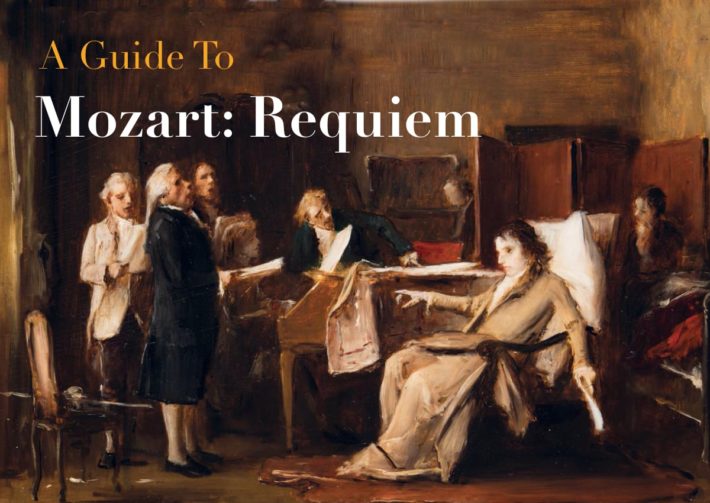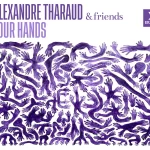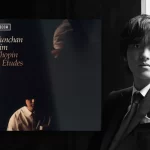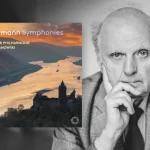Mozart’s Requiem has been a staple of the choral repertoire since its first publication in July 1800. Yet, when Mozart died on 5 December 1791, much of the work was left unfinished. Constanze, the composer’s wife, desperately needed the remainder of the commission fee, so she decided to have the work completed by another composer, someone from Mozart’s close circle of students and friends and pass it off as entirely by Mozart. The version widely performed and recorded today is the work of Franz Xaver Süßmayr, who assisted Mozart in the final months of his life.
Constanza had first asked Franz Beyer, Abbé Maximilian Stadler and a still unknown third person, to finish the piece; each of them did a bit of work – directly on the manuscript! – but then returned it incomplete, for unknown reasons. Süssmayr collated and revised the work of his predecessors, wrote the entire work out in his own hand (to makes it look like the work of a single composer) and falsified the date of completion with the strange inscription “di me (“by me”) W. A. Mozart /1792.”
Mozart Requiem – Analysis
A Requiem is a Roman Catholic mass for the dead: while it includes movements that are part of the daily mass (Kyrie, Sanctus and Agnus Dei), there are several other movements with texts of mourning and remembrance. The longest of these is the Sequence, written in the 1200s, with horrific imagery of God coming down from heaven to judge the world, punishing those who have lived and ungodly life with eternal damnation. Mozart’s Requiem has five main sections: Introitus, Sequence, Offertorium, Sanctus, Agnus Dei and Communio. The opening Introitus has two parts, “Requiem aeternam” and “Kyrie,” and this movement immediately presents one compositional aspect that makes the work so important within Mozart’s overall oeuvre.
Kyrie
Music of the Classical Period often employed homophonic texture: a primary melody, accompanied and harmonized by other voices. And in Mozart’s early masses, this is the predominant texture. But in the early 1780s Mozart became a regular visitor to the library of Baron Gottfried van Swieten, with its extensive music collection of Baroque music (especially works by Bach and Handel). As Mozart studied and performed this music, his compositional style began to incorporate more polyphonic writing. This is clearly heard in his “Mass in C-minor,” composed in 1782. But while in mass at times sounds like Mozart mimicking his Baroque predecessors, by 1791 Mozart had fully assimilated polyphonic writing into his compositional palette, and it is used throughout the Requiem. From the original manuscript, it’s clear Mozart intended each big section to end with a Fuge, and the Kyrie ends with a “Double Fuge”, which contains two main themes.
Sequence
This multi-sectioned movement is filled with vivid, often terrifying imagery: the cries of the damned begin the movement, “Dies irae, dies illa…” (Day of wrath, day of judgment, see the prophet’s warnings fulfilled, heaven and earth in burning ashes). Dramatic stuff indeed. Mozart’s writes breathlessly scurrying string figures, trumpets and drums sternly powerful, perhaps imitating God pounding his fist as he pronounces judgment. The orchestra’s busyness contrasts with the choir’s homophonic and homorhythmic texture – Mozart is ensuring the listener experiences (and understands) the panic of the text. “Tuba mirum” immediately follows, the trombone solo (ironically) portraying the text’s “wondrous trumpet.” The soloists enter from lowest-highest, the first three inhabiting the similar emotional territory,but the soprano brings a sudden change to an entirely different mood, singing the text “who intercedes for me when the just are in need of mercy?”
The following “Rex Tremendae” includes an especially impressive display of Mozart’s polyphonic mastery. The movement opens as unison strings present a dotted marching rhythm (dotted rhythms had signified royalty since the Baroque era), interrupted by three petrified cries of “Rex” (King) from the choir. A triple canon (between soprano/alto, tenor/bass, upper/lower strings) then begins, building to a powerful exclamation. All the energy quickly drains away, winds dropping out as the choir intones “Salve me…” (Save me, font of pity, defend us).
The “Recordare,” featuring the four soloists, is a much-needed respite from the dramatic atmosphere of the first three sections. Filled with long-breathed, gently intertwining melodic phrases, fear and trepidation are replaced by confidence that salvation will indeed be ours. That confidence is immediately shattered by the “Confutatis” opening: tenors and basses (in hell), hounded by violent and furious writing in the lower strings, cry “While the wicked are confounded, doomed to flames.” The women, in heaven, answer in a higher vocal range, accompanied only by the upper strings, Mozart using a literal distance between the choral parts to represent the gulf between heaven and hell.
“Lacrimosa” (Day of tears and mourning) finishes the Sequence. Legend traditionally says that the first eight measures are the last music Mozart ever wrote. Süssmayr then models the rest of the movement on the melodic pattern and sighing motive Mozart used in those first measures, but, as noted above, he fails to finish the movement with a fugue.
Offertorium
Like the first movement, this divides into two sections, “Domine Jesu Christe” and “Hostias.” The first section recalls the “Dies irae,” with scampering strings and homophonic choral writing, leading into particularly difficult, descriptive counterpoint at “ne absorbeat eas…” (That hell may now swallow them up). “Hostias” is a complete contrast, its sweet harmonies conveying our renewed confidence that our sacrifices and prayers may be enough to receive a pardon.
Sanctus, Agnus Dei and Communio
Süssmayr claimed to have written the final three movements on his own, but most scholars disagree. Most of the compositional errors are found in the orchestration; looking at the choral writing on its own, it seems much more idiomatically Mozartian. Süssmayr most likely had access to sketches that were later destroyed.
“Sanctus” opens homphonically in D major, followed by a brief fugue with an excellent theme (probably Mozart’s) poorly realized by Süssmayr. The four soloists return in “Benedictus,” its main theme being a melody that Mozart had written into the lesson book of his student Barbara Ployer, further evidence that Mozart did indeed leave behind sketches. Süssmayr is somewhat successful in mimicking the orchestration and sweetness of the “Recordare;” as tradition dictates, the movement ends with a reprise of the Sanctus fugue.
“Agnus Dei” brings a return to the home key, again featuring the contrast of a choral homophonic texture and vigorous, chromatic string writing. This section elides tenderly into the “Communio,” for which, following the instructions of Mozart, Süssmayr reuses the music of the “Introitus.”
Mozart Requiem – Various Completions
Over the last 50 years, several performers and musicologists have sought to correct and improve Süssmayr’s efforts. The first new edition, done by musicologist Franz Beyer in 1971, makes mostly small but clever changes in the orchestration, most notable in the solo arias. Its most audacious change appears at the end of the Sanctus and Benedictus fugues, where Beyer adds six new measures of music. These new measures opened a door to the possibility of changing and even adding music to Mozart’s unfinished torso.
Today there are several recordings featuring a variety of completions; several are listed below. The reader can learn more about the various completions by purchasing the recording by the Choir of Kings College Cambridge, listed below.
Recordings of the Various Completions
Here are six performances, each featuring a different completion; except for the Solti performance, all are on original instruments.
Franz Xaver Süssmayr Completion
English Baroque Soloists, Monteverdi Choir and Soloists,
Gardiner
A top choice for the traditional version on period instruments, Gardiner’s interpretation is intensely dramatic, with enthralling singing from the Monteverdi Choir and an incomparable vocal quartet. The recording, clear and focused, also includes a fabulous performance of Mozart’s “Kyrie in D-minor” (K. 341). Other recommended version of the Süssmayr on period instruments include Philippe Herreweghe, Christopher Hogwood and Jordi Savall.
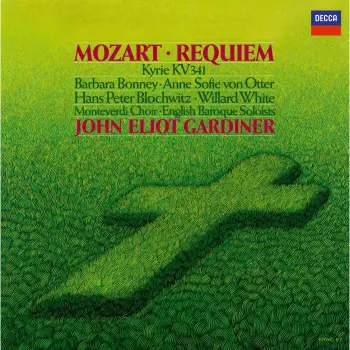
Find offer for this album on Amazon.
For those who seek a good performance of the Süssmayr on modern instruments, Neville Marriner’s version with the Academy of St. Martin-in-the-Fields is superb. The chorus is not as polished as Gardiner’s, but compensate with lively and involved performance throughout. The group of soloists are highly skilled, based on some of the leading voices of the era, including soprano Sylvia McNair and bass Robert Lloyd. Other versions worth exploring on modern instruments are by Leonard Bernstein, Karl Bohm, Claudio Abbado and Herbert von Karajan’s 1960’s performance.
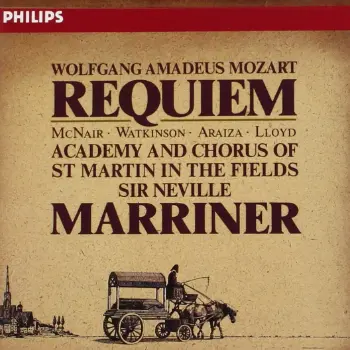
Find offer for this album on Amazon.
Franz Beyer Completion
Concentus Musicus Wien, Arnold Schoenberg Choir, Harnoncourt,
Harnoncourt recorded Mozart’s masterpiece in Beyer’s completion twice during his long recording career; this, his second recording, is far superior in every way to his first. The singing is exceptional, as is Harnoncourt’s complete mastery of the score. While his approach is not as dramatic as Gardiner’s, its more deeply considered approach is equally riveting. The inclusion of the hand-written score within the physical SACD hybrid is a bonus for the curious listener.
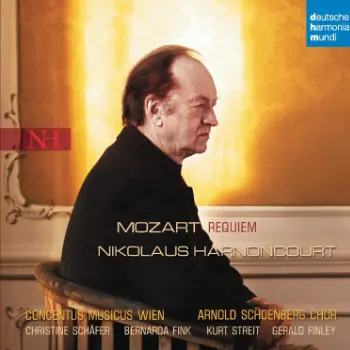
Find offer for this album on Amazon.
H. C. Robbins Landon Completion
Wiener Philharmoniker, Wiener Staatsopernchor, Solti
This recording has a uniquely special atmosphere. Documenting a live performance on 5 December 1991, the 200th anniversary of Mozart’s death, Solti’s approach is operatic, though he certainly allows for greater introspection than he would have a decade before. Featuring a star-studded quartet (Arleen Auger, Cecilia Bartoli, Vinson Cole and René Pape) their solo work is fabulous – their quartet singing, less so. The recording (made in the cavernous St. Stephen’s Cathedral) muddies some of the polyphonic writing. Nevertheless, the sense of occasion makes this recording special.
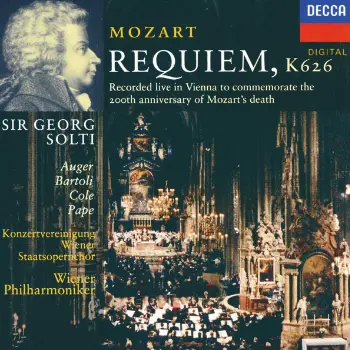
Find offer for this album on Amazon.
Robert Levin Completion
Scottish Chamber Orchestra, Chorus and Soloists, Mackerras
Levin’s completion has received five recordings, and this is the finest. Mackerras’s reading is dramatic and prayerful by turn, with fulsome choral singing, an impressive quartet and exciting playing by the SCO, captured in a Linn recording of exceptional warmth and detail.
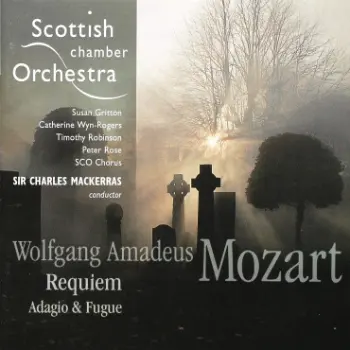
Find offer for this album on Amazon (second hand)
Various Completions
The Academy of Ancient Music, Choir of Kings College, Cambridge, Cleobury
The recording features a good (if not exceptional) performance of the Süssmayr completion, followed by different movements in five different completions. The highlight of this release, however, is not the performance itself but the companion disc, which features a lecture recital by Mozart scholar Cliff Eisen. In the lecture, Eisen discusses the work’s performance history and various completions, including ones not discussed in this article. For anyone interested in Mozart’s masterpiece, this is essential listening.
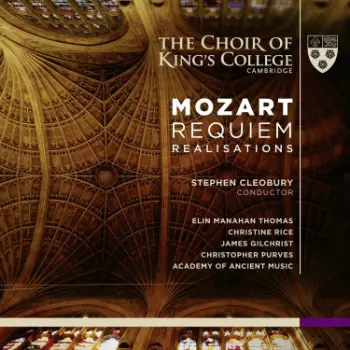
Find offer for this album on Amazon (second hand)

Albums are included with an Apple Music subscription:
Support Us
We hope this guide has helped you navigate the wonderful world of classical music! If you enjoyed this free resource, consider making a donation to The Classic Review. Your generosity helps us keep the music playing by allowing us to publish informative guides, and insightful reviews. Every contribution, big or small, allows us to continue sharing our passion for classical music with readers like you.
Donate Here
Recent Classical Music Posts
- Review: “Four Hands” – Alexandre Tharaud
- Review: Chopin – Études – Yunchan Lim
- Review: Britten – Violin Concerto, Chamber Works – Isabelle Faust
- Review: “Mozart, You Drive Me Crazy!” – Golda Schultz, Soprano
- Review: Schumann – Complete Symphonies – Dresdner Philharmonie, Janowski
- Review: Mozart – The Sonata Project, Salzburg – Yundi, Piano
Read more classical music reviews or visit The Classic Review Amazon store
Follow Us and Comment:
Get our periodic classical music newsletter with our recent reviews, news and beginners guides.
We respect your privacy.

